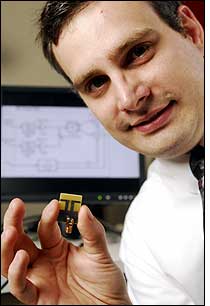Researchers at the Georgia Institute of Technology have developed a new system designed to help RFID hardware manufacturers measure the performance of hundreds of tags, as well as more quickly test new RFID tag prototypes, without having to actually construct new tags for each experiment.
“We can test antennas, inlays, anticollision schemes, modulation schemes—any type of experiment or invention that we dream up,” says Gregory Durgin, an assistant professor at the university’s School of Electrical and Computer Engineering. The testbed also enables companies to measure the signal strength of tags hidden behind other tags. Tags close to one another can steal each other’s power and dramatically reduce their range, so it is important to be able to study how signals fade for many close-together tags.

“One of the inspirations for our testbed was seeing how researchers were trapped inside existing RFID protocols and equipment, and were reduced to performing crude experiments that yielded very little design insight,” Durgin says. “They were descriptive, but not proscriptive. The results of those types of experiments don’t allow for engineering imagination to ask questions like, What are the physics of power scavenging among multiple tags? How might changing the modulation scheme enhance performance? What can I do to the antenna or inlay to improve the radio link?”
“Currently,” Durgin states, “designing and fabricating a new batch of RF ICs on a wafer of silicon can cost $30,000 to $100,000 or more, and take quite a bit of time. There is little chance to iterate and experiment with complicated signaling schemes. Not only could a testbed like ours save companies a lot of time and money, but it will also allow them to wring every last drop of range and reliability out of an RFID link.”
With better waveform and tag designs, Durgin says, the industry will be able to achieve “an order-of-magnitude increase in the range and reliability of current passive RFID systems. This would open up a huge new application space for identification, as well as sensors, telemetry, passive data exchange and medical sensing.”
The testbed is currently configured for measurements at 915 MHz UHF. The system consists of an RF transmitter, an RF receiver, a tag emulator and a computer system that coordinates all data acquisition. The emulator is a custom-built microwave circuit that clamps onto a tag antenna and contains some matching circuitry as well as a small PIN diode that simulates the presence of an RFID chip. “We also have a mechanical positioning track that can drag RF tags through space if we want to characterize ‘local area’ tag performance completely,” Durgin says. “That’s an optional component in our experiments.”
When a test is carried out, an emulator is attached to an antenna. The transmitter sends a radio signal to the antenna and emulator. In response, the antenna reflects back a unique spread-spectrum signal that is picked up by the receiver. Rather than fabricate a new chip to test new signaling schemes and frequencies, testers need only change the emulator’s signal.
“By sending a low-frequency data waveform to the PIN diode, we can control what signal it scatters back,” Durgin says. “This waveform is generated by a computer and fed by a set of thin wires or—in a future version—an infrared link. The PIN diode is driven by this signal and can emulate the full complement of loads that a real RF IC experiences during its signaling. Electrically, the emulator and the RF IC are identical.”
In addition, because each tag signal can be separated from the others, testers can simultaneously measure signals from multiple tags. One of the testbed’s developers, former Georgia Tech graduate student Anil Rohatgi, showed in his master’s thesis work that the testbed can measure the power strength and phase of up to 256 RFID tag emulator/antennas in the receiver’s field of view, an area approximately 20 feet in length, width and height.
“Each RF tag gets a uniquely coded spread-spectrum sequence,” Durgin says. “Although the receiver hears a cacophony of tags scattering back information, through signal processing we can filter out the unique codes and simultaneously measure the amplitude and signal phase of up to 256 RF tags in the same field of view. This is a scenario that makes industry RFID readers choke.”
The testbed is available now, and Durgin says he and his colleagues have already collaborated with Virginia-based Luna Innovations Inc. and several other companies involved in specialty RFID antennas and system measurements. “We recently finished a project with a company that was retrofitting an RFID tag with passive corrosion-sensing capability,” he notes. “It was a neat idea that could only be evaluated on our testbed, because of the non-standard antenna designs they were using.”
The research and development of the new testbed, funded by the National Science Foundation (NSF), was led by Durgin, Rohatgi and Joshua Griffin, currently a graduate student at Georgia Tech. The system was presented in April at the IEEE International Conference on RFID in Las Vegas.
Work first began on the testbed about five years ago, Durgin says. “We invented a simple testbed,” he states, “and at that time, we were simply interested in a way to test how the performance of 915 MHz RFID antennas changed when they were attached to different objects, such as wood, plastic, metal, liquid containers, etc. Since then, we have kept adding functionality and are currently in the middle of a five-year NSF project for developing new 5.7 GHz backscatter systems. No commercial technology operates this high in the microwave band, but there will be in a few years.”
The testing of RFID tags that operate at frequencies other than 915 MHz and 5.7 GHz is also a possibility. According to Durgin, several companies interested in experimenting with various kinds of new RFID sensors and multiple RF frequencies have contacted the university.

